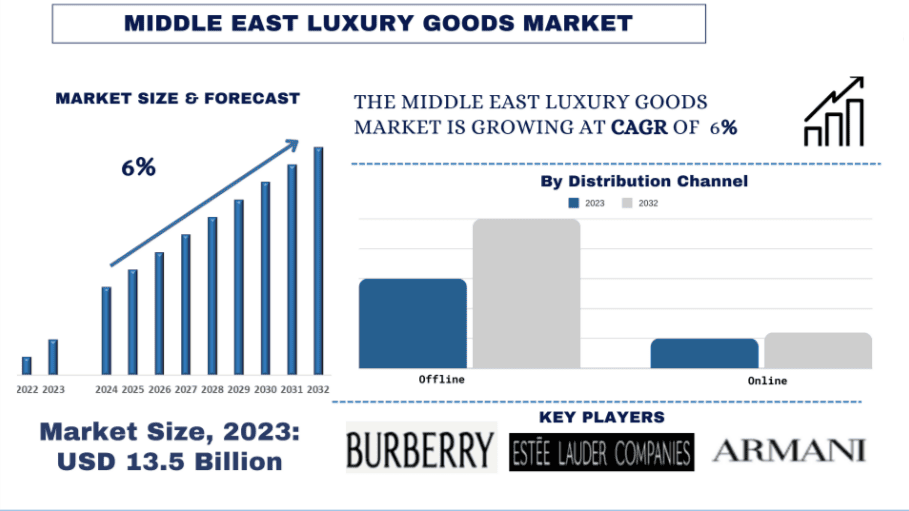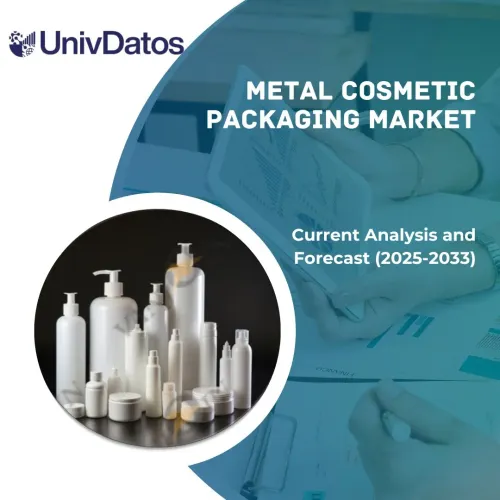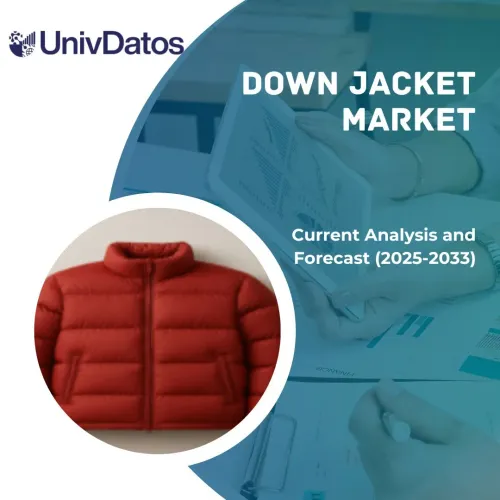- Home
- About Us
- Industry
- Services
- Reading
- Contact Us
Middle East Luxury Goods Market: Current Analysis and Forecast (2024-2032)
Emphasis on Product Type (Watches and Jewellery, Perfumes and Cosmetics, Clothing, Bags/Purse, and Others); Distribution Channel (Offline and Online); End User (Women and Men); Country.
Middle East Luxury Goods Market Size & Forecast
The Middle East Luxury Goods Market was valued at USD 13.5 Billion in 2023 and is expected to grow at a robust CAGR of around 6% during the forecast period (2024-2032).
Middle East Luxury Goods Market Analysis
- The luxury goods market refers to the segment of the consumer goods industry that focuses on high-end, premium-quality products and services that are associated with superior craftsmanship, exclusivity, and prestige. Luxury goods are often characterized by their exceptional quality, exquisite design, heritage, and brand reputation, and they typically command premium prices.
- The Middle East Luxury Goods Market is expected to grow at a strong CAGR of 6% during the forecast period owing to increasing government support. This support manifests in various forms, including investments in infrastructure development, tourism promotion, and policy initiatives to foster a conducive business environment for luxury brands. For instance, the United Arab Emirates (UAE) government has been instrumental in transforming Dubai into a global luxury hub through initiatives like the Dubai Shopping Festival (DSF) and Dubai Summer Surprises (DSS). These events attract millions of tourists annually and offer exclusive shopping experiences, discounts, and promotions, boosting luxury goods sales. Moreover, the government’s investments in iconic projects like the Dubai Mall, which houses numerous luxury boutiques and flagship stores, and the upcoming Dubai Expo 2020 are catalysts for the growth of the luxury goods market. The Expo is expected to attract millions of visitors, providing luxury brands an unparalleled platform to showcase their products and engage with consumers.
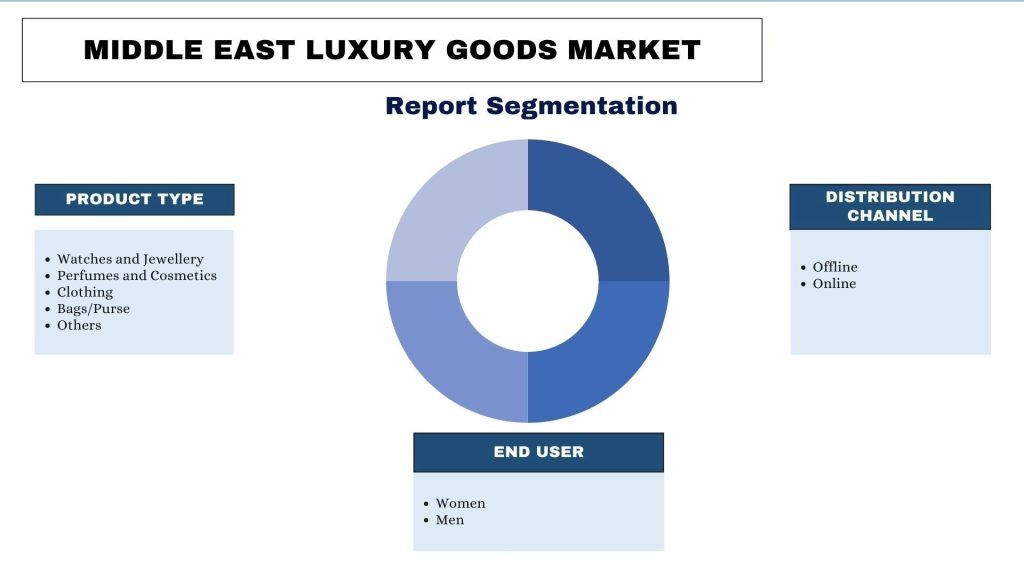
The Middle East Luxury Goods Market Segmentation
- Based on product type, the Middle East luxury goods market is segmented into watches and jewelry, perfumes and cosmetics, clothing, bags/Purses, and others. The Watches and Jewelry segment held the dominant share of the market in 2023. Leading international luxury brands renowned for their craftsmanship, design, and heritage dominate the watches and jewelry segment in the Middle East. Brands like Rolex, Cartier, Bulgari, and Tiffany & Co. have established strong footholds in the region and enjoy widespread recognition and consumer trust. The presence of prestigious brands enhances the allure of luxury watches and jewelry and reinforces their status as coveted luxury items.
- By Distribution Channel, the Middle East luxury goods market is segmented into Offline and Online. The offline segment held the dominant market share in 2023. This dominance underscores the enduring appeal of in-person shopping experiences in the region’s luxury market landscape. Affluent consumers in the Middle East often prioritize personalized service, exclusivity, and the immersive brand experiences of physical retail environments. These offline channels allow consumers to interact with luxury products firsthand, receive customized assistance from knowledgeable sales associates, and immerse themselves in the opulent ambiance of luxury boutiques. Additionally, offline retail channels offer a sense of security, trust, and authenticity, addressing concerns related to product quality, authenticity, and the luxury shopping experience.
- Based on End User, the Middle East luxury goods market is segmented into Women and Men. The women segment held the dominant share of the market in 2023. This dominance can be attributed to various factors specific to the region’s cultural, social, and economic landscape. In Middle Eastern societies, women often possess significant purchasing power and are key decision-makers in luxury consumption. They have a keen interest in fashion, beauty, and lifestyle products, and they actively seek out luxury brands that offer a blend of quality, style, and prestige. Moreover, the Middle East has a rich tradition of celebrating special occasions and events, where women play central roles as brides, bridesmaids, and guests. Luxury fashion, accessories, jewellery, and cosmetics are essential to these celebrations, driving demand among female consumers.
Saudi Arabia held a dominant share of the market in 2023
Several factors contribute to Saudi Arabia’s prominent position in the luxury goods sector. Firstly, the country boasts a sizable population of affluent consumers with significant purchasing power, fueled by its vast oil reserves and thriving economy. Additionally, Saudi Arabia’s cultural and social landscape emphasizes luxury consumption, with a strong appreciation for prestigious brands, high-quality craftsmanship, and opulent lifestyles. The Kingdom’s cosmopolitan cities, such as Riyadh, Jeddah, and Dammam, are home to luxury shopping destinations, upscale malls, and exclusive boutiques that cater to the discerning tastes of affluent residents and visitors alike. Furthermore, government initiatives aimed at diversifying the economy and promoting tourism have bolstered the luxury goods market in Saudi Arabia, attracting international luxury brands and fostering a competitive retail environment. As a result, Saudi Arabia stands out as a key market within the Middle East luxury goods industry, driving innovation, growth, and consumer demand across various product categories.
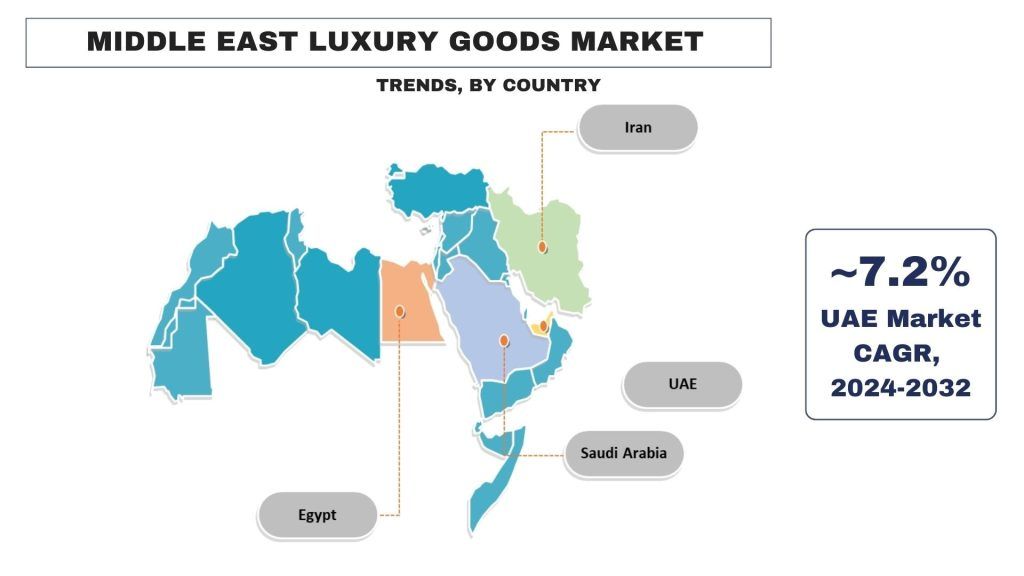
Middle East Luxury Goods Industry Overview
The Middle East Luxury Goods Market is competitive and fragmented, with the presence of several regional and international market players. The key players are adopting different growth strategies to enhance their market presence, such as partnerships, agreements, collaborations, new product launches, geographical expansions, and mergers and acquisitions. Some major players operating in the market include Burberry Group plc, Chanel S.A, Compagnie Financière Richemont S.A., Dolce & Gabbana Luxembourg S.À R.L., Giorgio Armani S.p.A, Kering S.A., LVMH Moët Hennessy Louis Vuitton, PRADA S.P.A., Rolex SA, and The Estée Lauder Companies Inc.
Middle East Luxury Goods Market News
- In November 2022, Santos de Cartier introduced a new line of jewelry collections, comprising rings, bracelets, and necklaces. The collection showcases a gold chain in two colors, adorned with a single or double row of coffee beans embellished with diamonds of various sizes.
- In May 2022, PRADA Tropico expanded its footprint by inauguring an exclusive pop-up boutique in Dubai. Situated at the Mall of Emirates, the boutique offers a vibrant array of luxury accessories, including raffia-style bags, striking hats, and small accessories in bold hues. The pop-up store employs a captivating blend of colorful stripes and dynamic lighting effects to craft an immersive retail environment.
- In May 2021, a new Rolex Boutique debuted at the Galleria Al Maryah Island in Abu Dhabi, the capital of the United Arab Emirates. The boutique boasts a distinctive “watchbar” and several seating areas for patrons to relax. A VIP room is also available, showcasing the extensive collection of timepieces with pride.
Middle East Luxury Goods Market Report Coverage
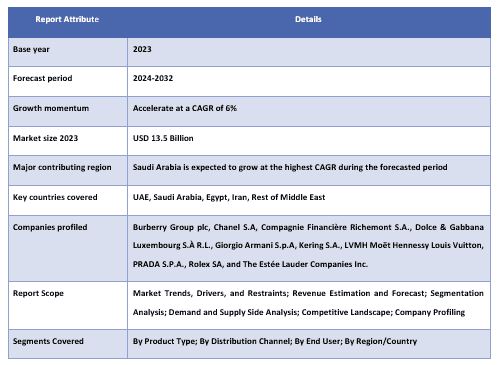
Reasons to buy this report:
- The study includes market sizing and forecasting analysis validated by authenticated key industry experts.
- The report presents a quick review of overall industry performance at one glance.
- The report covers an in-depth analysis of prominent industry peers with a primary focus on key business financials, product portfolios, expansion strategies, and recent developments.
- Detailed examination of drivers, restraints, key trends, and opportunities prevailing in the industry.
- The study comprehensively covers the market across different segments.
- Deep dive regional level analysis of the industry.
Customization Options:
The Middle East Luxury Goods Market can further be customized as per the requirement or any other market segment. Besides this, UMI understands that you may have your own business needs, hence feel free to connect with us to get a report that completely suits your requirements.
Table of Content
Research Methodology for the Middle East Luxury Goods Market Analysis (2024-2032)
Analyzing the historical market, estimating the current market, and forecasting the future market of the Middle East Luxury Goods Market were the three major steps undertaken to create and analyze the adoption of Middle East Luxury Goods in major countries. Exhaustive secondary research was conducted to collect the historical market numbers and estimate the current market size. Secondly, to validate these insights, numerous findings and assumptions were taken into consideration. Moreover, exhaustive primary interviews were also conducted, with industry experts across the value chain of the Middle East Luxury Goods Market. Post assumption and validation of market numbers through primary interviews, we employed a top-down/bottom-up approach to forecasting the complete market size. Thereafter, market breakdown and data triangulation methods were adopted to estimate and analyze the market size of segments and sub-segments of the industry pertains to. Detailed methodology is explained below:
Analysis of Historical Market Size
Step 1: In-Depth Study of Secondary Sources:
Detail secondary study was conducted to obtain the historical market size of the Middle East Luxury Goods Market through company internal sources such as annual reports & financial statements, performance presentations, press releases, etc., and external sources including journals, news & articles, government publications, competitor publications, sector reports, third-party database, and other credible publications.
Step 2: Market Segmentation:
After obtaining the historical market size of the Middle East Luxury Goods Market, we conducted a detailed secondary analysis to gather historical market insights and share for different segments & sub-segments for major regions. Major segments are included in the report as product type, distribution channel, and end user. Further country-level analyses were conducted to evaluate the overall adoption.
Step 3: Factor Analysis:
After acquiring the historical market size of different segments and sub-segments, we conducted a detailed factor analysis to estimate the current market size of the Middle East Luxury Goods Market. Further, we conducted factor analysis using dependent and independent variables such as product type, distribution channel, and end user of the Middle East Luxury Goods Market. A thorough analysis was conducted for demand and supply-side scenarios considering top partnerships, mergers and acquisitions, business expansion, and product launches in the Middle East Luxury Goods Market.
Current Market Size Estimate & Forecast
Current Market Sizing: Based on actionable insights from the above 3 steps, we arrived at the current market size, key players in the Middle East Luxury Goods Market, and market shares of the segments. All the required percentage shares split, and market breakdowns were determined using the above-mentioned secondary approach and were verified through primary interviews.
Estimation & Forecasting: For market estimation and forecast, weights were assigned to different factors including drivers & trends, restraints, and opportunities available for the stakeholders. After analyzing these factors, relevant forecasting techniques i.e., the top-down/bottom-up approach were applied to arrive at the market forecast for 2032 for different segments and sub-segments across the major markets. The research methodology adopted to estimate the market size encompasses:
- The industry’s market size, in terms of revenue (USD) and the adoption rate of the Middle East Luxury Goods Market across the major markets domestically
- All percentage shares, splits, and breakdowns of market segments and sub-segments
- Key players in the Middle East Luxury Goods Market in terms of products offered. Also, the growth strategies adopted by these players to compete in the fast-growing market
Market Size and Share Validation
Primary Research: In-depth interviews were conducted with the Key Opinion Leaders (KOLs) including Top Level Executives (CXO/VPs, Sales Head, Marketing Head, Operational Head, Regional Head, Country Head, etc.) across major regions. Primary research findings were then summarized, and statistical analysis was performed to prove the stated hypothesis. Inputs from primary research were consolidated with secondary findings, hence turning information into actionable insights.
Split of Primary Participants
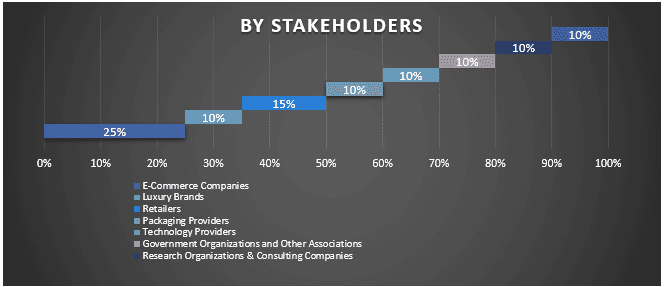
Market Engineering
The data triangulation technique was employed to complete the overall market estimation and to arrive at precise statistical numbers for each segment and sub-segment of the Middle East Luxury Goods Market. Data was split into several segments & sub-segments post studying various parameters and trends in the areas of the product type, distribution channel, and end user in the Middle East Luxury Goods Market.
The main objective of the Middle East Luxury Goods Market Study
The current & future market trends of the Middle East Luxury Goods Market were pinpointed in the study. Investors can gain strategic insights to base their discretion for investments on the qualitative and quantitative analysis performed in the study. Current and future market trends determined the overall attractiveness of the market at a country level, providing a platform for the industrial participant to exploit the untapped market to benefit from a first-mover advantage. Other quantitative goals of the studies include:
- Analyze the current and forecast market size of the Middle East Luxury Goods Market in terms of value (USD). Also, analyze the current and forecast market size of different segments and sub-segments.
- Segments in the study include areas of the product type, distribution channel, and end user.
- Define and analysis of the regulatory framework for the Middle East Luxury Goods
- Analyze the value chain involved with the presence of various intermediaries, along with analyzing customer and competitor behaviors of the industry.
- Analyze the current and forecast market size of the Middle East Luxury Goods Market for the major countries.
- Company profiles of the Middle East Luxury Goods Market and the growth strategies adopted by the market players to sustain in the fast-growing market
- Deep dive country level analysis of the industry
Frequently Asked Questions FAQs
Q1: What is the current market size and growth potential of the Middle East Luxury Goods Market?
Q2: What are the driving factors for the growth of the Middle East Luxury Goods Market?
Q3: Which segment has the largest Middle East Luxury Goods Market share by product type?
Q4: What are the emerging technologies and trends in the Middle East Luxury Goods Market?
Q5: Which country will dominate the Middle East Luxury Goods Market?
Related Reports
Customers who bought this item also bought

